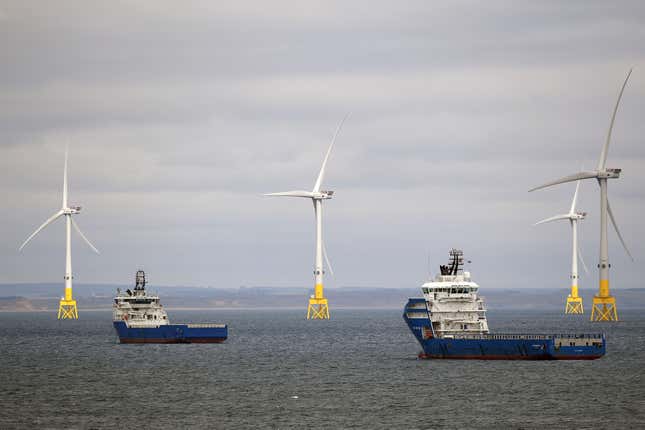
Wind is picking up speed on the West Coast. California plans to produce 10 to 15 gigawatts of offshore wind energy by 2045—enough to power between 10 million and 15 million homes, according to a report by the state’s Energy Commission released on Friday. The goal is the biggest of any state so far, surpassing New York’s 9 gigawatt by 2035 pledge.
California’s SB 100, signed into law 2018, mandates the state reach 100% renewable energy by 2045, and offshore wind is part of the plan to get there. Plus, nationally the Biden administration set a goal of 30 gigawatts of offshore wind energy by 2030. California’s draft plan includes a preliminary goal of 3 gigawatts of offshore wind for 2030—10% of the federal target.
For context, California’s 3,437 miles of coastline make up just about 3% of the total U.S. shoreline mileage (accounting for all states, territories, islands, and the Great Lakes coast). Granted, not all of that is suitable for offshore wind turbines. And in 2021, the entire U.S. energy grid, including small-scale solar, had a generating capacity of about 1,170 gigawatts.
Those initial 3 gigawatts of West Coast wind power would come from a “full build-out of the Morro Bay Wind Energy Area (WEA) or a combination of a partial build-out of the Morro Bay WEA and Humboldt WEA,” said the report.
Last year, the Biden administration opened up those two California sites (one in Morro Bay, the other off the coast of Humboldt farther north) to offshore wind, and specifically to floating wind turbines.
Generally, offshore wind farms are located in areas shallow enough to secure turbines directly to the ocean floor with concrete or steel pylons. However, floating wind farms are a relatively new technology that enables turbines to be tethered with cables in areas of deeper water.
The first floating wind farm began producing energy in 2017 off Scotland’s coast. As of 2021, only two additional operational floating farms have popped up: another in Scotland and one off the coast of Portugal. More conventional offshore wind though, has taken off in Europe in recent decades.
But basically everywhere offshore wind and floating farms have been proposed or constructed in the U.S., they’ve faced big backlash. In Maine, lobster fishermen were concerned about the effects a lengthy power cable would have on their ability to fish, even though a transition to clean energy production is likely necessary to keep lobster populations viable. On Long Island, some very rich property owners in the Hamptons lobbied against an offshore wind farm, citing unfounded fears of “violent energy releases” and “electromagnetic fields.”
Last September, a group of commercial fishermen sued the Department of the Interior for not adequately considering their concerns in the approval of a a 62-turbine project near Martha’s Vineyard.
More recently, in California, lots of stakeholders, including members of the Northern Chumash Tribe, have criticized and fought a private proposal to float eight wind turbines within the bounds what may become a tribal marine sanctuary. Much of the opposition there comes down to the specifics of the sensitive location, a lack of existing data on wind farm environmental impacts in similar places, and the companies involved, who aren’t members of the responsible development group Offshore Wind California, according to reporting by the Los Angeles Times.
As valid as it is to assess and consider offshore wind’s industry and environmental impacts (like we should with all major infrastructure), it’s important to keep in mind that the alternative to expanding these energy projects is to keep burning fossil fuels. We have plenty of data irrefutably demonstrating the harm that the status quo of oil, gas, and coal is causing both people and natural environments. If we want to really ensure the oceans are protected, we need as many renewable gigawatts as possible.
Regardless, California’s new draft goals are likely to stir up additional controversy, but for now they’re non-binding and preliminary. A finalized announcement of the plan is set to come on May 24.